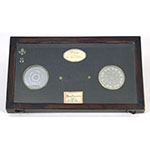These metalochromes consist of polished steel disks with iridescent patterns produced by a thin film of lead oxide deposited electrochemically. The color of the patterns varies according to the thickness of the film through which the light is reflected by the polished steel surface.
Leopoldo Nobili first observed this phenomenon in 1828. The steel disk was immersed in a bath containing an electrolytic solution of lead acetate (he later also used other solutions) and was connected to the positive pole of a Voltaic battery by means of one of the platinum points of his apparecchio a punte ["points apparatus"] (Inv. 1234, 1271 - inv. 1241 - inv. 1242). The negative pole of the battery connected to the other point was slightly above the disk. The thickness of the film was varied by lowering or raising the points. Complex patterns could be made in this way, or by placing a card with a cut-out shape on the steel disk, followed by a copper disk that was slightly curved so that its distance from the steel varied. The metalochromic technique was fairly popular in the nineteenth century and was used to decorate small items such as snuff boxes and clock cases. Provenance: Lorraine collections.










